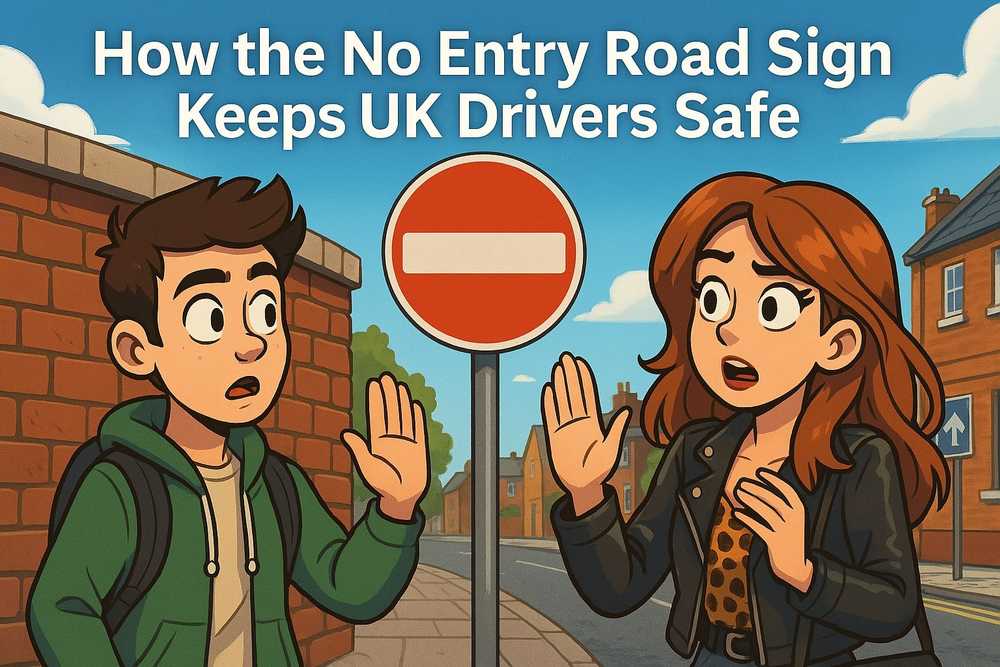How the No Entry Road Sign Keeps UK Drivers Safe
The No Entry Road Sign plays a crucial role in keeping UK residents and tourists safe, whether they are driving or riding. The highway code, introduced in 1931, has been a cornerstone of UK road safety. It is regularly updated to reflect modern driving conditions and technological advancements. In addition to promoting uniformity across the United Kingdom, it helps protect motorists, pedestrians, cyclists, and others on the road, while ensuring traffic continues to flow efficiently, even in hazardous or emergency situations.
A significant component of the Highway Code is the traffic sign system. Traffic signs not only enhance road safety by establishing clear rules but also ensure consistency in shape and color. This consistency makes them easily recognizable across the UK, helping drivers quickly identify and understand their meaning regardless of location. Alongside common signs like Stop and Give Way, there are other road signs of critical importance that regulate driver behavior. One such sign is the No Entry Road Sign.
Step 1 – What is the No Entry Road Sign?
The No Entry Road Sign is a common sight in the UK and internationally. It is designed to warn drivers that vehicles are prohibited from entering a specific road or section of a road. Typically, this sign is placed at the entrance of roads where entry is not permitted.
Although some believe that emergency vehicles in the UK are generally exempt from ‘No Entry’ signs, They must adhere to traffic laws unless responding to emergencies where safety and operational requirements allow exceptions.
In the United Kingdom, emergency vehicles such as police cars, fire engines, and ambulances are granted specific exemptions from certain traffic regulations to facilitate prompt responses to emergencies. These exemptions include the authority to disregard certain traffic signs, such as “No Entry” signs, when adherence would impede their emergency duties. However, these exemptions are exercised with strict adherence to safety protocols to ensure public safety is not compromised.
The legal framework for these exemptions is outlined in the Traffic Signs Regulations and General Directions 2016 (TSRGD 2016), which permits emergency vehicles to:
- Disregard “No Entry” signs: Emergency vehicles may enter areas restricted by “No Entry” signs if necessary for their operational duties.
- Exceed speed limits: Under Section 87 of the Road Traffic Regulation Act 1984 , vehicles used for fire brigade, ambulance, or police purposes are exempt from speed limits if observing them would hinder their use for emergency purposes.
- Proceed through red traffic lights: Emergency vehicles can treat red lights as give-way signs, allowing them to proceed through intersections when safe to do so.
- Disregard certain directional signs: They may pass on the incorrect side of keep left/right signs when necessary.
These exemptions are conditional upon the following:
- Use of audible and visual warnings: The activation of sirens and flashing lights is typically required to alert other road users.
- Ensuring public safety: Drivers must exercise due care, ensuring that their actions do not endanger the public or other road users.
It’s important to note that while these exemptions provide operational flexibility, they do not grant carte blanche to emergency vehicle drivers. Each situation is assessed individually, and drivers are trained to balance the urgency of their response with the overarching need to maintain public safety.
Step 2 – Where is the No Entry Road Sign Commonly Found?
Typically, No Entry Road Signs are posted for safety reasons. That is, to avoid a head-on collision or other accident. In theory, the sign keeps the driver from facing opposing traffic or going the wrong way on a road. You’ll often find this sign at the entrances of one-way streets, on motorway off-ramps to prevent wrong-way entry, and at restricted areas like private property or pedestrian-only zones. However, sometimes they are at intersections where the traffic pattern quickly changes from a two-way to a one-way road.
Step 3 – What is the history behind the No Entry Road Sign and why is it important?
Although traffic signs can be traced back to ancient civilization and the Roman Empire, people became serious about traffic control and traffic safety with the onset of the automobile in the early 1900s. The Road Traffic Act of 1930 empowered the Minister of Transport to prescribe regulations for traffic signs, leading to the Traffic Signs (Size, Colour and Type) Provisional Regulations in 1933, which standardized signs such as direction signs, warning signs, and the ‘No Entry’ sign.
Step 4 – When should drivers obey this sign?
The No Entry Road Sign is cautionary and should be treated as such. In summary, it means just what it says, that is – Do Not Enter. Instead, for your safety and the safety of others, you should turn your vehicle around and go another way. Consequently, drivers should always obey the No Entry Road Sign because it can be a lifesaver. If you come up on a No Entry Road Sign unexpectedly, abide by it. Simply refer to GPS or a map to try to find an alternate route.
Step 5 – Penalties for ignoring the No Entry Road sign
Ignoring a “No Entry” road sign in the UK is considered a traffic offense under Section 36(1) of the Road Traffic Act 1988 and the Traffic Signs Regulations and General Directions 2016. The standard penalty for this violation is a £100 fine and three penalty points on the driver’s license. In more serious cases, especially if the offense leads to dangerous situations or accidents, the matter may be escalated to court. If convicted, the fine can increase up to £1,000, and the driver may still receive three penalty points.
Accumulating 12 or more penalty points within a three-year period can result in a driving disqualification under the “totting-up” procedure. It’s important to note that if ignoring a “No Entry” sign results in a collision, the driver would likely be deemed negligent and held liable for any damages arising from the incident.







